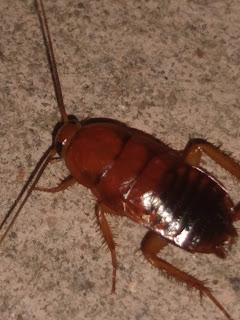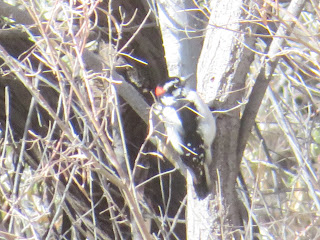Thanksgiving is for a lot more than just stuffing our faces, although that seems to be the clear and stated goal of most gatherings. The same is true in the natural world as well.
Cranes gather in the fields around Corrales to indulge in free corn hand-outs and fallen apples, However, if you look closer you can see the interactions of displaying and group behaviors as these big birds begin to court and pair off. Officially, cranes breed in early spring when they migrate north, but cranes are one of the few birds that actually mate for life, and pair bonding is an important part of their normal behaviors.
The male wood duck's behaviors are very odd, and seem to be mostly about drawing attention away from the drab female and toward itself. The crazy red eyes are very prominent and the male is protective and overbearing towards the quieter female. Still, these birds are quite shy. They flee and hide under low hanging branches in the water readily when approached, all while whistling shrilly.
Ducks, and especially mallards are famous for forced copulation and hybridization with at least 40 other duck species. This is as a result of the weird sexual selection pressures that encourages bizarre and colorful courtships and structures in most birds. Mallards are very adaptable to human presence. Indeed, they are the ancestors of the larger and more plain colored domestic duck.
The American widgeon is a smaller duck often found with a flock of mallards. These birds prefer more secluded and wooded lakes and beaver ponds of the far north.
The great blue heron is not often seen fishing as they seem to prefer the quiet period between dusk until dawn. Dog walkers who are out in the evening can often be startled by the loud "gronk" sounds of a disturbed bird, interrupting the calm hooting of the horned owls in the trees.
The belted kingfisher is a very noisy and twitchy bird that also hunts the ditches in very distinct territorial areas. These are not easy birds to catch on camera while holding still. This is my excuse of the blurry picture, anyway.
As the water begins to freeze in the mornings, the fishing birds will need to move to areas of more open water, and deeper water. Shallow water freezes solid, but because ice floats, most water deeper than a few inches stays at a constant temperature of 4 degrees Celsius until warmed by the afternoon sun. The rich black mud below often hides many types of hibernating creatures. From tadpoles to crayfish, insects, and turtles.

Clay is used for a lot more than just pretty pots. Clay particles travel long distances suspended in water and settle out in predictable locations where water is not flowing. In prehistory times humans used a wrapping of clay to cook food in fires, like foil. Puddled clay was used long before adobe brick to build solid houses. Clay is water impermeable even when not fired, but also holds water in electrostatic bonding when it is found in sandy soils. If the water and air are removed by repeated pounding of trail traffic, the resulting compact mass is air and water tight and cannot support any plant growth. Moisture from rain, and the resulting freeze and thaw cycles, craze the surface into roughly hexagonal cracks. Conversely, drying out clay mud also forms hexagonal cracks as the calcium salts within the alkaline mud crystallizes and contracts. This dry mass often forms a fine powder during the summer on the trails.

The surface of the levee roads are composed of clay mixed with enough sand to prevent these cracks. The herons rest here to digest fish caught. The open spots between stand of cattails are often liberally splattered with the white, guanine rich deposits of digested fish which are a mixture of feces and concentrated uric acid. Apparently, someone once wrote a 100 page book on the excretory habits of the great blue heron, but I was unable to preview a copy.
"The Defecation Behavior of Great Blue Herons and Great Egrets in the
South Carolina Piedmont, and Greenhead Shiner Responses to Great Blue
Heron Feces". By Lawrence M. Slavitter.
Sounds like riveting reading, and might actually cover many interesting topics about predator defense, tree nesting, parasites, weight of water, and other topics. The internet, however mostly focuses on articles related to its effect of car paint. The world we live in.
There are over 12,000 species of grasses currently known, so it is no surprise that this plant family has a lot of variety. The most noticeable, from this picture, is that some grasses grow throughout the winter, and others die back after seeding. The implications of the difference in behavior between annual and perennial is very profound and is one of the major divisions used by gardeners to choose plants for a garden.

In this field are the invasive plumes of the Ravenna grass, that is just beginning to make itself felt in Corrales after moving up the Rio Grande Valley since becoming established in the 1970's at the Biopark. Pampas grass is a pretty ornamental grass from Brazil that dies back because it cannot survive the cold winters. Ravenna grass is a related plant, but on steroids in that it is absolutely cold hardy. This makes it attractive for gardeners and has allowed thick stands of feral stands to become established along the river banks. As of right now, the chances of eradication are non-existent. The consequences of this plant thriving are uncertain, but likely bad without co-originated action.

Beavers are well known as watershed engineers. If left alone, these mammals help manage and control water flows and the associated ecosystems. Beavers control cattails by raising the water level. The dam structures also host musk rats that eat cattails directly. It is a pity the dredging operations keep moving these busy guys away, but they always seem to come back, and appear to be thriving.

The value of the interior drain is argued about by different groups. This picture shows a drain section just south of the Elementary school. With the overburden of soil removed, the poplar seeds were able to contact wet ground and have grown into three year old cottonwood trees. This area, right in the median of 2 busy dirt roads, is one of the few places in the bosque that cottonwoods are thriving in their ideal growing conditions. Even though we know where and how to grow cottonwoods, competing interests mean that with our children's lifetimes, cottonwoods will likely be replaced by species such as Siberian elms, Ravenna grass, and box elder.

When Corrales has the choice to grow, development looks very different than what people would expect of a village with a nature preserve, historical society, and thriving arts and culture. This brand new fire hydrant by the school does help expensive houses reduce the costs of insurance and undoubtedly helps the fire department do the job it is here to do. Sadly, however, right next to this new hydrant are the remains of the Elementary school
constructed wetlands treatment system that was abandoned once the new associated sewage system was installed. Plans by the interior drain committee would extend these pipes along the interior drain, destroying this wetland ecosystem balance of plants, insects, and animals.

This is the turkestan cockroach. This is rapidly becoming the most common roach in the Southwest. It is rare in Corrales because of the colder winter temperatures and increased animal predation. It is fast replacing the oriental cockroach as it breeds faster and does not interact with humans and their poisons as much. The problem is, along with drain flies and the inland mosquito, they survive better and breed inside underground pipes and are likely to become far more common as wells and septic systems are replaced with water treatment plants and fire hydrants.

Ants are very common in Corrales through out the year. Most rural ants stay away from human houses because they have no need to be inside. Their diets change depending on resources and most ants cache seeds in the spring and summer, and often scavenger dying insects in the fall. This one has found a small honey snack. The ants in the city survive by aggressively seeking out human food and defending it from other ants through sheer weight of numbers. With the combined weight of ants on the planet equal to 20% of total human biomass, it is clear they cannot simply be eradicated.
Many insects rely on humans. This grasshopper is resting on stucco on an east facing wall. This means it will warm quickest, all insects are at a disadvantage in the cold, but are still surprisingly active by the warm afternoon.
Flies lose much of their zip in cold weather and it is actually rare to see them outside in the morning. This common house fly can actually be picked up until the air temperature reaches at least 40 degrees.
Hunting spiders can tolerate colder temperatures and probably rely on this to extend their hunting season. This type of ground spider runs down its prey, making it perfectly adapted to catching cold stunned insects in the mornings.
The grey buckeye butterfly is one of the last butterflies to disappear as the days get colder. They can sequester plant poisons and have warning coloration in those wing spots.
The bosque is an ever changing place that is artificially managed and yet more under the control of nature's cycles than most parts of the state of New Mexico. While the problems and threats faced by nature are numerous, I am still thankful to be able to live in such a vibrant and thriving location of breathtaking natural beauty. That is something we could all take a moment to feel more thankful for.



































































